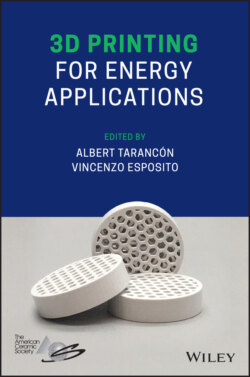Читать книгу 3D Printing for Energy Applications - Группа авторов - Страница 27
1.3.2 Functional Material Gradients in DED
ОглавлениеA promising application of functionally gradient AM is the replacement of problematic dissimilar metal welds with additively manufactured graded transition joints. In the nuclear and aerospace industries, failures related to joints, and interfaces between dissimilar metals are frequent [54]. Typical joining processes produce sharp gradients in composition and properties that ultimately promote failure mechanisms in service. Furthermore, designs are limited by the need to assemble many individual parts composed of different materials in order to meet various services and cost requirements. Hence, for the case of low‐volume, high‐complexity parts, incorporating functional grading with additive manufacturing presents an attractive alternative. A major advantage of using gradient AM techniques is the ability to fabricate custom compositions, using phase diagrams as a map between desired compositions. In traditional alloy development, multicomponent alloys are made one point at a time until the phase diagram is understood. The gradients in AM processes allow for many compositions along a line to be fabricated in the same part, thus accelerating alloy development. For each gradient alloy, a defined gradient path can be selected for the AM building process, thus unlocking the possibility to reach the desired phase while avoiding the detrimental intermetallics. Table 1.1 below gives an overview of recent research on functional DED components.
Parts can be designed with gradient material properties and can be made by changing powder input. By doing this, the material behavior could be designed across the part by utilizing the changing material/mechanical properties of the material. In an example from Gu, Meiners, Wissenbach, Poprawe [23], a Ni‐Cr part was made with a designed negative coefficient of thermal expansion. Ideally, this process could be used to make structures that are piezoelectric and even have a negative Poissons ratio or make a ductile metal with a negative thermal expansion. Compositional gradation also increases the overall properties and integrity of the part since weld‐seam stress concentrations weakening joints are reduced. Hofmann et al. [69] performed finite elemental analysis (FEA) and have shown that a gradient transition in an automobile valve stem from steel to Inconel has approximately 10 times less stress concentration at the transitioning zone compared to a traditionally welded joint at the same operating temperatures. Another FGM example is that of LENS‐deposited Inconel transitioning to a copper alloy for increased thermal conductivity behaviors in high temperature heat exchangers. The conductivity of the bimetallic structures increased by almost 300% compared to Inconel 718 [70].
The review articles by Bandyopadhyay and Heer [20] list out several applications and research studies conducted on multi‐material AM components. Hence, in Table 1.1, the focus was on more recently published work and classifying them according to Type II–IV material gradients. The rapid increase in research on FGAM's and better DED process control, coupled with new software modules for design and simulation of FGAM components, indicates the potential for growth in this section. The ultimate goal is to have integrated materials design freedom at the voxel‐scale and the process‐control necessary to manufacture the designed FGAM's. Out of all the metal AM processes, DED is the closest toward achieving complete material design freedom.
Table 1.1 An overview of recently representative work on different types of materials gradients in DED.
| Materials | Type‐II | Function | References |
|---|---|---|---|
| 316/IN625 | Optimized to avoid cracks | [55] | |
| IN625/Cu | Bimetallic structure for thermal applications | [56] | |
| IN718/SS316L | Change in hardness and mechanical strength with no cracking | [57] | |
| TA15/IN718 with Cu/Nb interlayers | Interlayers allow the manufacture of traditionally unweldable alloys | [58] | |
| Type‐III | Continuous gradients | ||
| IN625/NiCrAlY | Functionally graded interface with few/no cracks | [59] | |
| 2.25Cr‐1Mo‐Steel/Alloy 800H | Graded Ferritic to Austenitic steels with limited Carbon diffusion | [60] | |
| Bulk metallic glasses Zr50 alloy (BMG) | Large gradient BMG structures that are otherwise difficult to produce | [61] | |
| Ti/Ti‐6Al‐4V | Compositionally graded with phase and microstructural control | [62] | |
| Ti‐6Al‐4V/Invar | Continuously graded samples with no cracks compared to the discrete interface | [63] | |
| Type‐IV | Composites + Continuous gradients | ||
| Ti‐B4C composite | TiB precipitate control leads to MMC with equiaxed, fine α grains | [64] | |
| Cp Ti‐NbC composite | Metal‐ceramic composites for high impact, high toughness applications (armor) | [65] | |
| Ti‐Al2O MMC w/ nanopowders | Fine α2 lamellar microstructure within a Ti matrix. High hardness was achieved | [66] | |
| TiB‐Ti composites | 3D quasi‐continuous precipitate network with high strength | [67] | |
| Hybrid Ti‐6Al‐4V wire + WC powder | High hardness and wear‐resistant composite | ([68]) |
